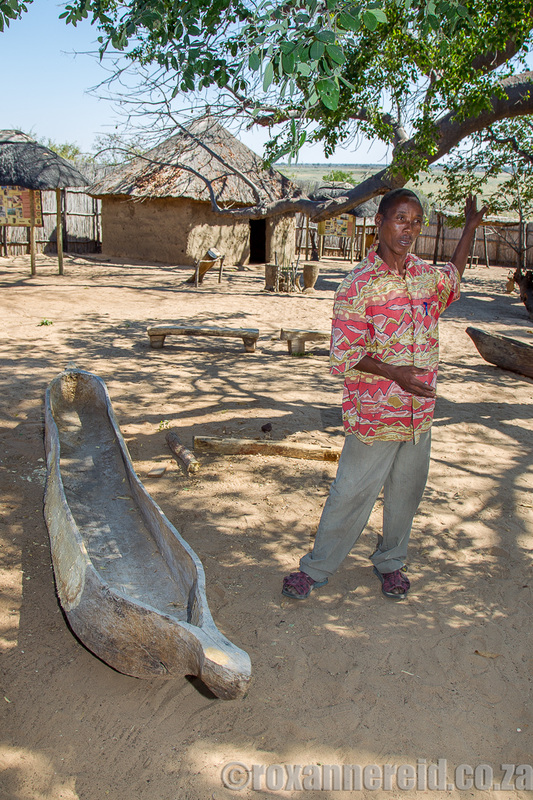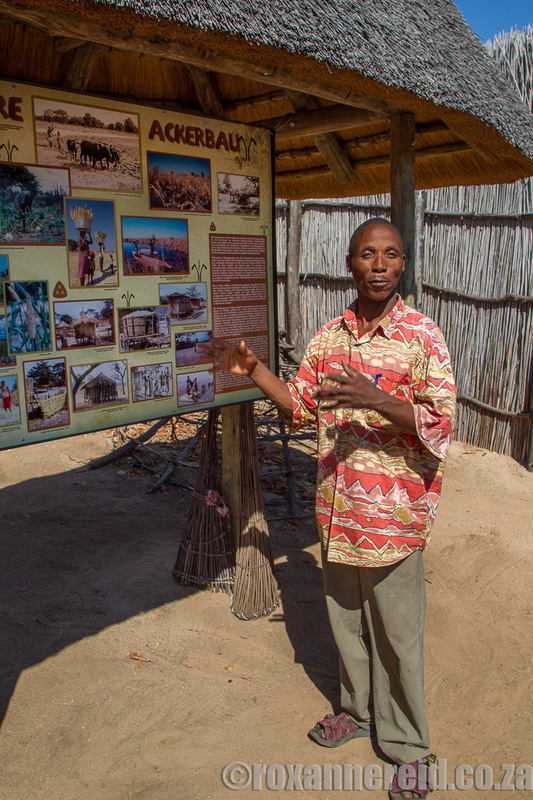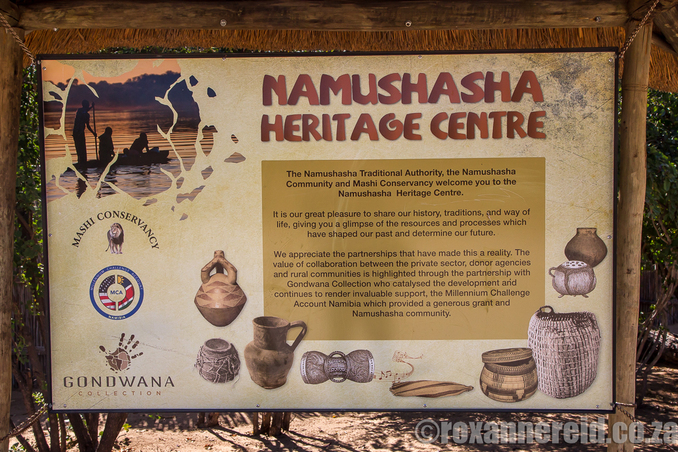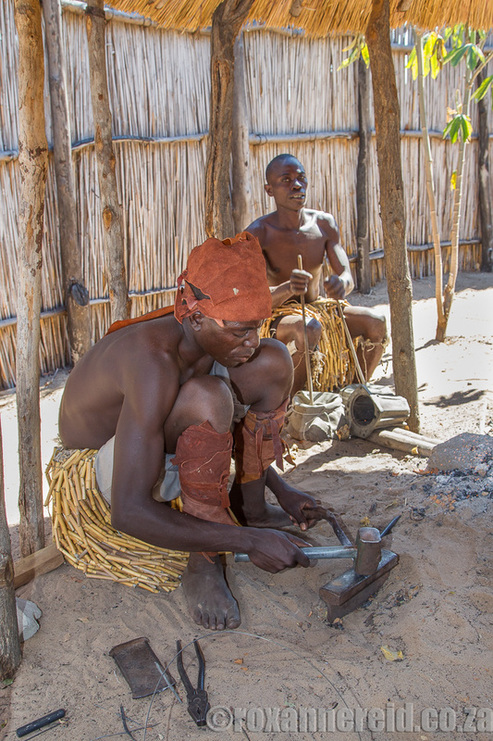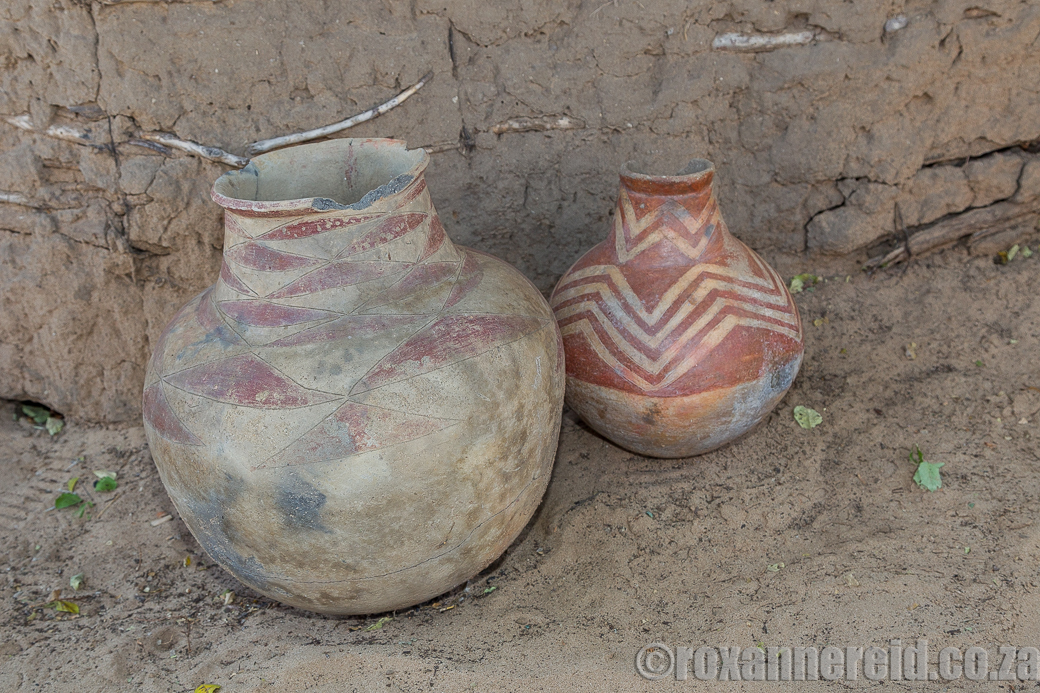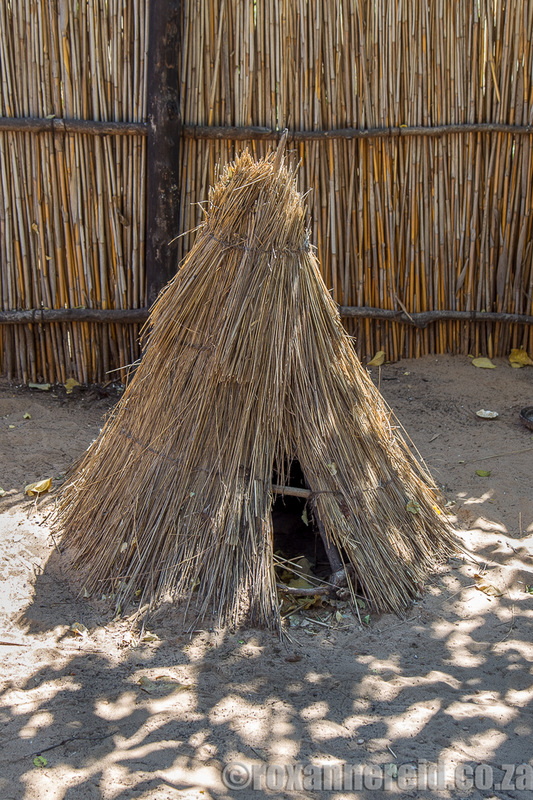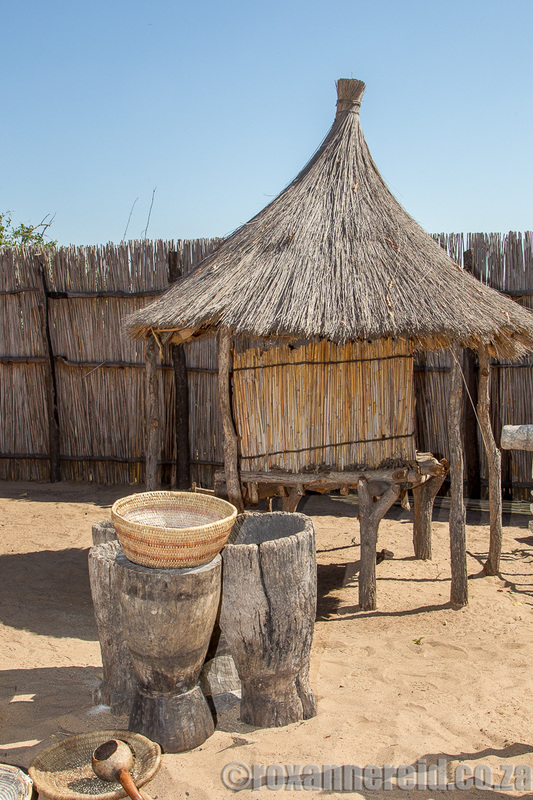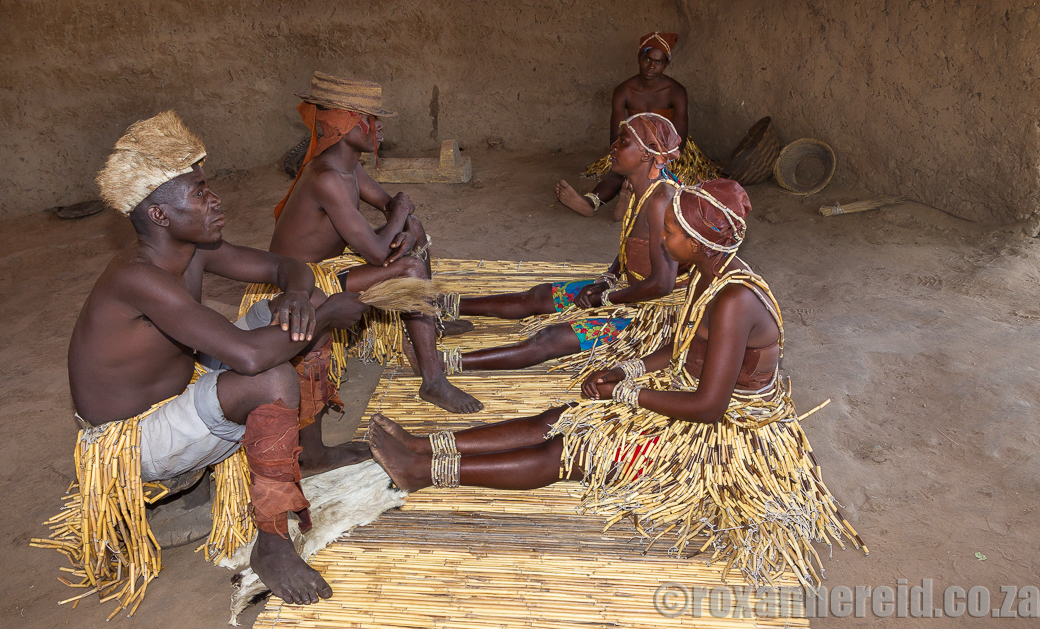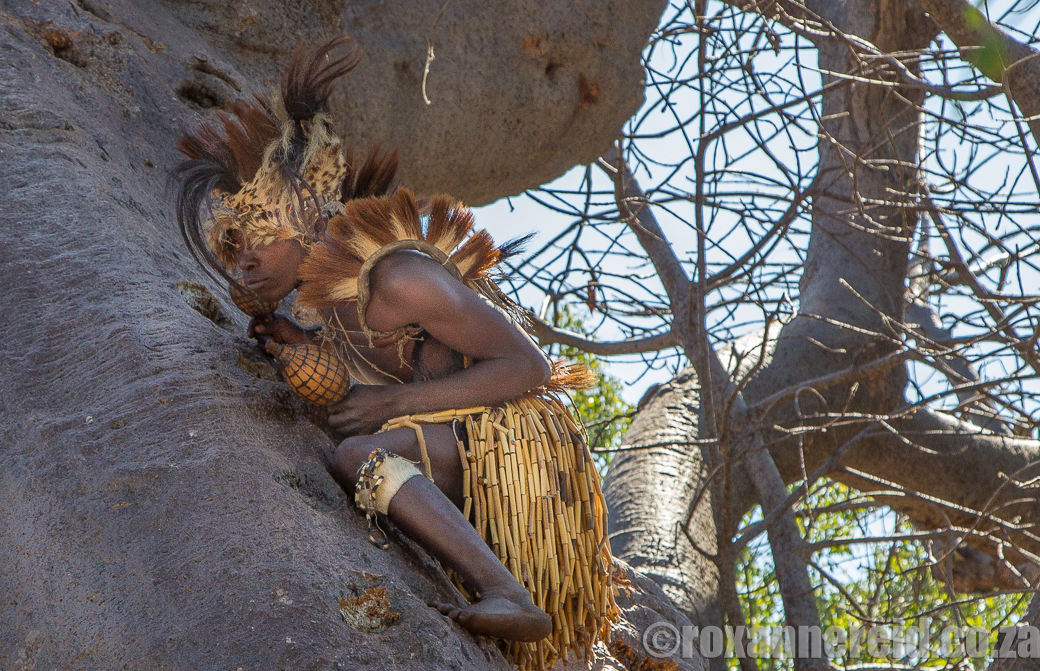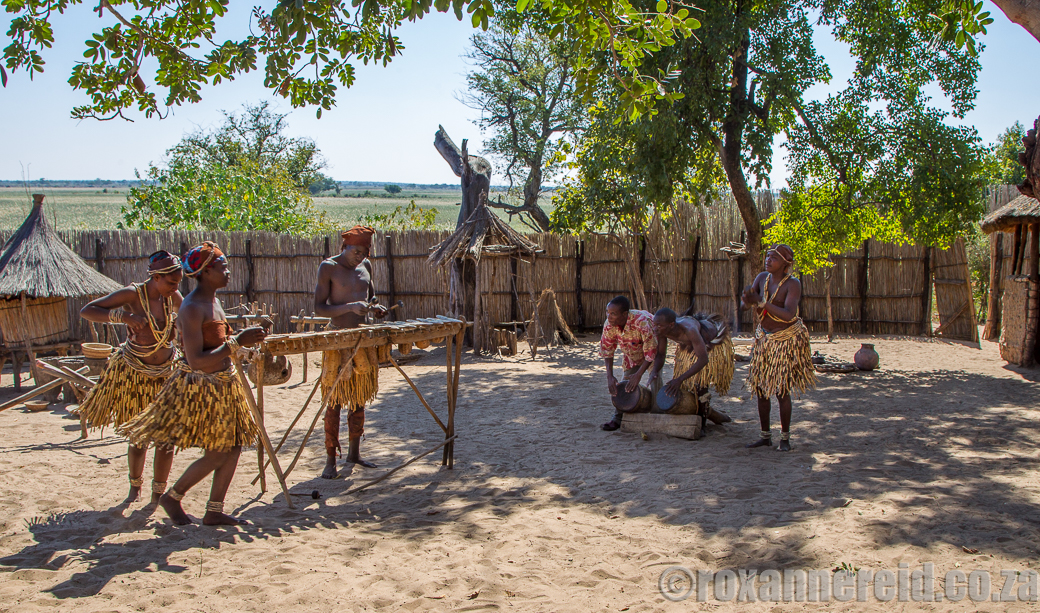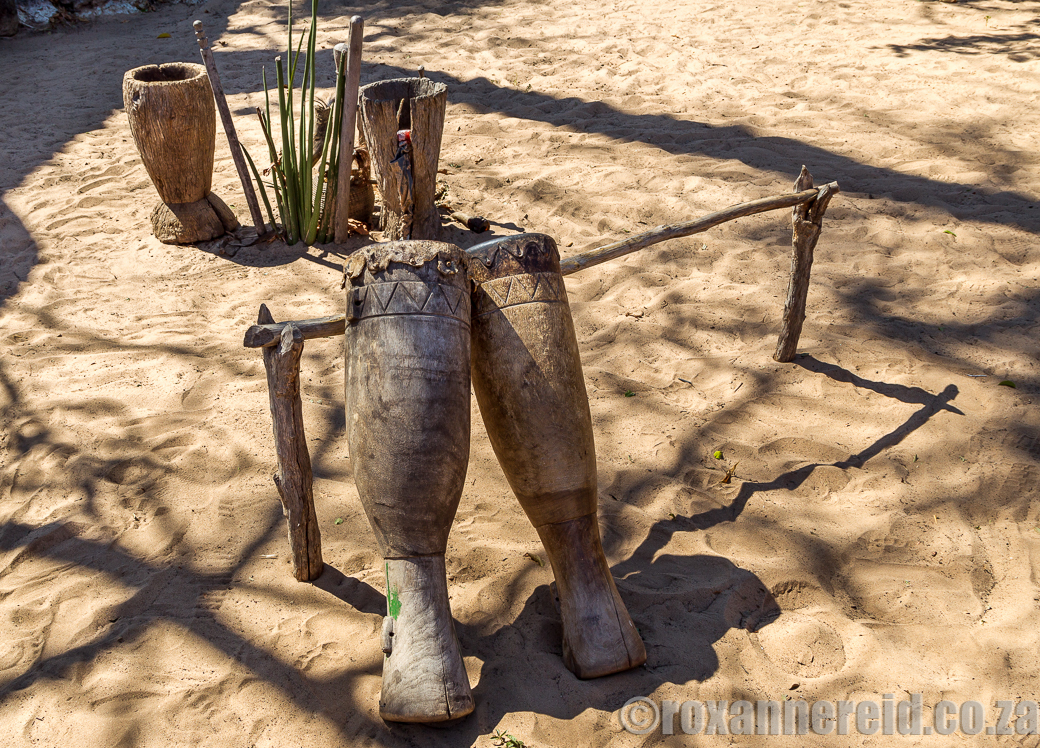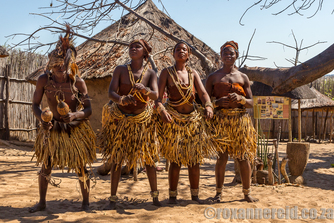
By Roxanne Reid
The Namushasha Heritage Centre in Namibia’s Zambezi (formerly Caprivi) was opened in 2014 to showcase the history and traditions of some of the people of the region. To get there, we walked along a riverside trail from the Namushasha River Lodge but you could just as easily make a stop on your way to or from Kongola.
The Namushasha Heritage Centre in Namibia’s Zambezi (formerly Caprivi) was opened in 2014 to showcase the history and traditions of some of the people of the region. To get there, we walked along a riverside trail from the Namushasha River Lodge but you could just as easily make a stop on your way to or from Kongola.
The sound of drumming and singing carried through the trees as we approached. We found a little settlement humming with activity under a giant baobab. The centre was funded by the Millennium Challenge Account and the Gondwana Collection and many well-illustrated info boards told of the culture and traditions of local people like the HaMbukushu, BaLozi and MaFwe.
Boniface was on hand to talk us through the highlights. A small, thin man with a high-pitched, rasping voice, he told us about the wooden canoe I know as a mokoro but here is called a mikolo.
They’re usually carved from a single trunk of mulombe (kiaat) or musheshe (wild syringa) and usually takes a man about three to four weeks of hard work to produce one. He explained that kiaat was popular because it was unsinkable but was so caught up in his patter that he skipped over my question about what it was that made it so unsinkable. He also showed us a mikolo made of very heavy Zambezi teak.
They’re usually carved from a single trunk of mulombe (kiaat) or musheshe (wild syringa) and usually takes a man about three to four weeks of hard work to produce one. He explained that kiaat was popular because it was unsinkable but was so caught up in his patter that he skipped over my question about what it was that made it so unsinkable. He also showed us a mikolo made of very heavy Zambezi teak.
Thanks to the abundance of water in this area along the Kwando River, fishing plays an important role in the subsistence economy. Tigerfish, barbel, yellowfish, tilapia, pike and squeaker are some of the species locals catch to eat. The men fish from canoes, but both men and women also use traps. In the floodplains large cone-shaped traps, made of reeds and very narrow at one end, are used to catch small fish. Some fishermen use large circular fishing traps made of split bamboo stems. They’ll often wrap the fish in water grass (musuhela) so it stays fresh for longer, then sell it fresh or dry it on the roofs of the village huts.
The locals also plant crops such as millet, beans, ground nuts, maize, sorghum and pumpkins.
Skills and crafts
Every man is expected to learn the skill of wood carving, using marula, bloodwood and other wood to make items like stools, wooden pots and dishes. They also make sleighs to use for transport – items that weren’t originally used in Eastern Zambezi but introduced after missionaries and traders brought ox wagons to the area in the 19th century.
The locals also plant crops such as millet, beans, ground nuts, maize, sorghum and pumpkins.
Skills and crafts
Every man is expected to learn the skill of wood carving, using marula, bloodwood and other wood to make items like stools, wooden pots and dishes. They also make sleighs to use for transport – items that weren’t originally used in Eastern Zambezi but introduced after missionaries and traders brought ox wagons to the area in the 19th century.
I enjoyed the hands-on demonstration by two men who showed how they still make tools from scrap metal, using two small drum-like bellows they pumped with sticks to get the fire hot enough to make the metal workable.
Basketry is left to the women, who use the fan palm, grasses and reeds as raw materials. They most use a coiled technique and usually decorate them with coloured patterns. They boil the leaves or roots of trees to get black, brown and reddish or yellow-brown dyes.
Basketry is left to the women, who use the fan palm, grasses and reeds as raw materials. They most use a coiled technique and usually decorate them with coloured patterns. They boil the leaves or roots of trees to get black, brown and reddish or yellow-brown dyes.
Functionality is the main component of most items the locals produce, and we saw traps of all sizes for animals from rats to antelope, two kinds of chicken houses, as well as elevated stores to keep grain away from rats. All the huts were also built using local reeds, grasses and mud.
The khuta and the medicine man
Boniface explained that a chief is born, not chosen, so only the sons or brothers of the former chief are eligible. He has the power to veto any decisions made by the khuta, or chief’s council. We watched an enactment of how the khuta works, much like a magistrate’s court.
Boniface explained that a chief is born, not chosen, so only the sons or brothers of the former chief are eligible. He has the power to veto any decisions made by the khuta, or chief’s council. We watched an enactment of how the khuta works, much like a magistrate’s court.
Two young women with a ‘dispute’ entered the hut on their knees, clapping with cupped hands as a sign of respect. Each gave her side of the story and then it was ruled on by the council. After every pronouncement, the women clapped again. I liked how practical the solution was: the woman whose cattle had broken into the other’s food store had to give her four sacks of meal in compensation.
The medicine man – or inganga – is also known as the zebra man because he wears a zebra mane on his head. He uses antelope horns to communicate with his patients, and other devices like a fly whisk, an axe and a tortoise to help point out a thief. One of the info boards pointed out: ‘Most tools and plant ingredients have a psychological rather than a medicinal value.’
The man playing ‘medicine man’ the day we visited was a real medicine man still in training, learning about the plants and processes he needed to serve his people. He wore a skirt (mashamba) of reeds and bark strings and climbed up the giant baobab with the agility of a squirrel.
The man playing ‘medicine man’ the day we visited was a real medicine man still in training, learning about the plants and processes he needed to serve his people. He wore a skirt (mashamba) of reeds and bark strings and climbed up the giant baobab with the agility of a squirrel.
Singing and dancing
For me the best part of our visit was at the end, with singing and dancing to the beat of drums and the melodies of the wooden marimba. The reed skirts of the dancers became musical instruments themselves, rattling more loudly the faster the wearers danced, forming patterns as their hips swayed. The dancers seemed to enjoy themselves, their faces coming to life as they danced, whereas before they’d seemed demure and rather shy.
For me the best part of our visit was at the end, with singing and dancing to the beat of drums and the melodies of the wooden marimba. The reed skirts of the dancers became musical instruments themselves, rattling more loudly the faster the wearers danced, forming patterns as their hips swayed. The dancers seemed to enjoy themselves, their faces coming to life as they danced, whereas before they’d seemed demure and rather shy.
On our way out, we stopped in the small shop to buy a well-carved wooden elephant. Carvings, baskets and other crafted items were each carefully marked with the crafter’s number and entered in a ledger so he or she would be paid accordingly.
Why you should visit a heritage centre
I know some people are conflicted about heritage centres, feeling that they’re not always authentic. For me, though, they serve a dual purpose. First, they give travellers a chance to learn about a different culture – something that isn’t always easy to achieve unless you know one of the locals who will invite you to their home.
Second, and perhaps more importantly, in a time when many traditions are being lost as the younger generation embraces 21st century Western ways, heritage centres help to preserve some of the older traditions that might otherwise be lost, they reinforce cultural dignity and they provide an income for the local community.
I know some people are conflicted about heritage centres, feeling that they’re not always authentic. For me, though, they serve a dual purpose. First, they give travellers a chance to learn about a different culture – something that isn’t always easy to achieve unless you know one of the locals who will invite you to their home.
Second, and perhaps more importantly, in a time when many traditions are being lost as the younger generation embraces 21st century Western ways, heritage centres help to preserve some of the older traditions that might otherwise be lost, they reinforce cultural dignity and they provide an income for the local community.
Need to know
You might also enjoy:
River highlights of northeastern Namibia
Camping paradise at Kwando Camp
Cruising down the Kwando River in northeastern Namibia
Game drive in Bwabwata Natiional Park, Namibia
Copyright © Roxanne Reid - No words or photographs on this site may be used without permission from roxannereid.co.za
- The Namushasha Heritage Centre is about 20km south of Kongola on the C49. Take the turnoff from the B8 to Namushasha River Lodge and you’ll pass the centre on your right-hand side a few kilometres before you get to the lodge.
- The centre is open from 8:00 till 16:30 and a tour takes about 90 minutes. There’s a small shop where you can buy local crafts.
- If you’re camping, you’ll love Namushasha’s campsite with its river views, green grass and private ablutions that are super-clean. There’s power for part of the day and a donkey boiler for showers. The sites along the riverfront are superb for tents and trailers, though you’d have to choose carefully for a caravan because of access to the terraced sites, some of which aren’t flat. Campers are welcome to use the swimming pool at the lodge.
You might also enjoy:
River highlights of northeastern Namibia
Camping paradise at Kwando Camp
Cruising down the Kwando River in northeastern Namibia
Game drive in Bwabwata Natiional Park, Namibia
Copyright © Roxanne Reid - No words or photographs on this site may be used without permission from roxannereid.co.za
